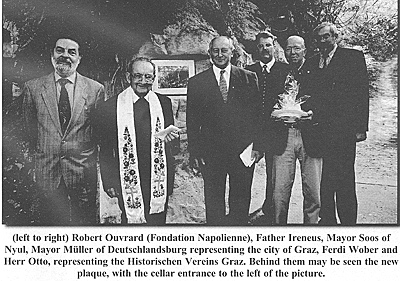Memorial to Honour the Graz Landwehr
and an Unknown Hungarian Girl
Napoleonic Newsdesk
by Paul Chamberlain, UK
| |
Following on from his research into the Battle of Raab (now Gyoir in Hungary) on 14th June 1809 (see FE No.60 'A Trip to Raab'), Austrian historian Ferdi Wober has been looking into the fate of the 2nd Graz Landwehr Battalion (from the province of Styria). Its 435 men under Major Hummel formed part of the garrison of the Kismegyer farm, with elements of IR27 and IR61. Also with them was a young Hungarian female camp follower, who was helping with the wounded. (left to right) Robert Ouvrard (Fondation Napolienne), Father Ireneus, Mayor Soos of Nyul, Mayor Müller of Deutschlandsburg representing the city of Graz, Ferdi Wober and Herr Otto, representing the Historischen Vereins Graz. Behind them may be seen the new plaque, with the cellar entrance to the left of the picture. At the end of the battle, the surviving 103 Landwehr with 9 surviving officers, were marched off as prisoners to the nearby village of Nyul, where the officers were taken to local houses but the Landwehr men were held in the local wine cellars, which are dug into the side of a local hill. Prince Eugene considered them irregular insurgents and intended to have them shot by firing squad the next morning. The young Hungarian girl was among the prisoners and managed to escape that night, though it is not certain whether she was dressed as a man or woman. Reaching the Austrian outposts, she told an officer about Eugene's order and was taken to Army HQ. Archduke John sent an ADC to inform Eugene that the Landwehr were an integral part of the Austrian Army and if any Landwehr man were shot, two French prisoners would be executed. Eugene quickly cancelled the order! On September 27th 2003, a memorial plaque was dedicated in Nyul in memory of the Graz Landwehr men. After a brief description of the battle at the famous Raab monument near Kismegyer farm, a formal ceremony of dedica- tion took place in Nyul that afternoon. The local mayor, Colonel Zachar (representing the Hungarian National Army Museum) and Father Ireneus made short speeches and the local children presented a mix of Austrian and Hungarian tunes and dances, while the Graz Burgerkorps stood guard. The ceremony concluded appropriately with some local wine in the cellars as Ferdi Wober explained the fate of the Austrian troops. Unfortunately, it has not been possible to identify the young girl, but Ferdi is continuing his research. Napoleonic News Desk
Wellington's Smallest Victory: The Duke, the Model Maker and the Secret of Waterloo Back to Table of Contents -- First Empire # 74 Back to First Empire List of Issues Back to MagWeb Master Magazine List © Copyright 2004 by First Empire. This article appears in MagWeb.com (Magazine Web) on the Internet World Wide Web. Other articles from military history and related magazines are available at http://www.magweb.com |

 (Submitted by Dave Hollins)
(Submitted by Dave Hollins)